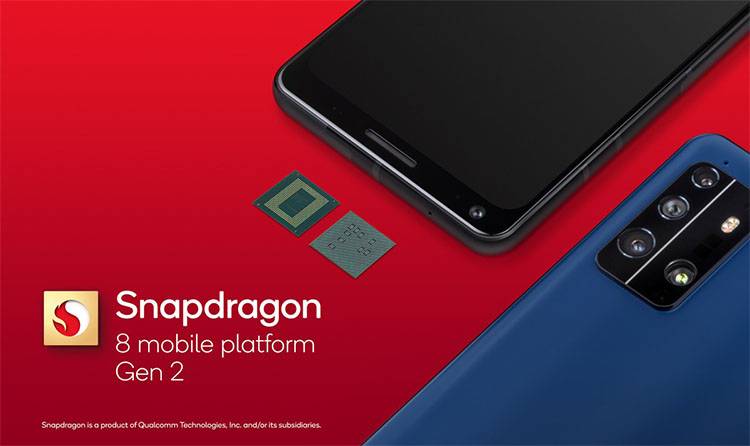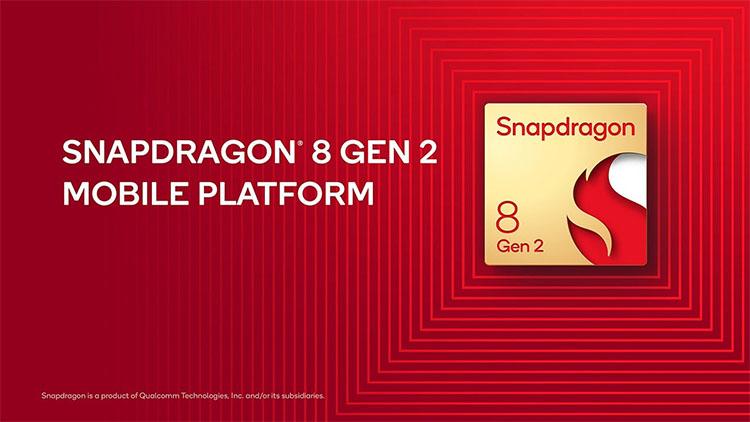The Snapdragon 8 Gen 2 chipset, the latest flagship from Qualcomm, was introduced. Performance has increased compared to the Gen 1 model, and we will soon experience this performance since the first Gen 2 devices are just around the corner.
The SM8550-AB is the name of this chip, and it was made on a 4nm node. Here are some specifics regarding its parts.

Specifications
Now for the specifics: TSMC's 4nm production node is used to manufacture the Snapdragon 8 Gen 2. A single potent Cortex-X3 core running at 3.2GHz, four Cortex-A715 cores running at 2.8GHz, and three Cortex-A510 cores running at 2.0GHz are all included. Thankfully, Qualcomm chose the more energy-efficient A715 core this time rather than the A710 substance (released in July 2022). Qualcomm claims that the Snapdragon 8 Gen 2's CPU offers 35% more performance than the Snapdragon 8 Gen 1. It also uses 40% less energy, which is a significant improvement.
As a side note, Qualcomm has utilized the more advanced and power-efficient A510 cores to maintain 32-bit functionality.
Please note that Google has discontinued 32-bit support with the launch of the Pixel 7 series. When it launches next year, there won't be any 32-bit builds with Android 14. Therefore, the Snapdragon 8 Gen 2 CPU may be the last from Qualcomm to support 32-bit architecture.
Display Technical support
Regarding support for on-device displays on the 8 Gen 2, the GPU can power a QHD+ panel at a maximum refresh rate of 144Hz. In addition, it can operate at up to 4K at 60Hz. The answer is yes if you're asking whether the SoC can power a screen up to 4K at 60Hz. It also supports display-out for external monitors. It helps 10-bit color depth, Dolby Vision, HDR 10, HDR 10+, and more. However, OEMs will determine whether or not they are available.
CPU Design Improvement
With the release of the Snapdragon 8 Gen 2 this year, Qualcomm has finally fundamentally altered the CPU design. A 1+3+4 CPU design, consisting of 1 primary core, three gold cores, and four efficiency cores, was available on previous-generation 800-series and 8 Gen 1 chipsets. Qualcomm switched to a new Kryo CPU design (1+4+3) this time, consisting of 1 primary core, four gold cores, and three efficiency cores.
According to experts, Qualcomm implemented this design change to fight with the best of the competition and take the lead in CPU performance tests. The business also decided to adopt a new octa-core architecture because mid-cores have recently become more effective and performing.
Efficient Adreno 740 GPU
Regarding the GPU, the Snapdragon 8 Gen 2 is equipped with the most recent Adreno 740 GPU, which is rumored to perform on par with other top SoCs. The Adreno 740 GPU, according to Qualcomm, performs up to 25% quicker while using 40% less energy. Although this statistic compares to 8 Gen 1, double-digit performance gains and efficiency numbers are still noteworthy.
Camera Systems
According to Qualcomm,
Samsung's 200MP HP3 and
Sony's Digital Overlap HDR (DOL-HDR) sensors have been tuned to function with the Snapdragon ISP. Like its predecessor, the Gen 2's triple 18-bit ISP can support up to three 36MP cameras operating at 30 frames per second or up to 200PM for a single camera. 108MP sensors can offer zero shutter lag.
The chipset can capture 64MP images and 8K HDR video at 30 frames per second, 4K at 120 frames per second and slow-motion videos (720p at 960fps). Among the compatible HDR codecs are HDR10+, HLG, and Dolby Vision. Using DOL sensors, it can capture up to four exposures for each video frame.
Ahead of Time
According to Qualcomm's press announcement, prominent Android manufacturers like Asus ROG, Honor, iQOO, Motorola, nubia, OnePlus, Oppo, Red Magic, Sharp, Sony, Vivo, Xiaomi, Meizu, and ZTE will use the Snapdragon 8 Gen 2 chip.
The article continues by stating that the first Gen 2 phones will be out before the end of this year, although it doesn't specify which manufacturers will release them first. Samsung and the new S23 series are not mentioned.

